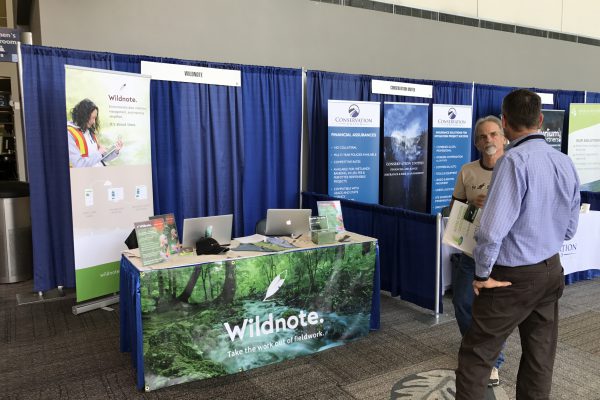National Mitigation and Ecosystem Banking Conference
Last week, the 20th annual National Mitigation & Ecosystem Banking Conference (NMEBC) was held in Sacramento, California. Mitigation banking leaders, representatives from federal and state regulatory agencies, environmental field data collection service companies and non-profit organizations were all represented. The conference was an opportunity for attendees to share information, demonstrate the efficiency of environmental data collection software, and to collaborate on efforts to protect and restore our environment.
It’s really all about the interaction both in the sessions, as well as conversations, off to the side, over a cup of coffee, at a display booth. It is a tremendous opportunity for sharing information [Steve Martin, USACE]
“It’s really all about the interaction both in the sessions, as well as conversations, off to the side, over a cup of coffee, at a display booth. It is a tremendous opportunity for sharing information,” explains Steve Martin, environmental scientist for the US Army Corps of Engineers – Institute for Water Resources, during an interview with NMEBC staff.
Infrastructure and Development Support Environmental Protection
The ecological restoration industry helps mitigate the environmental impact of infrastructure and development, while facilitating growth of the US economy. This successful partnership generating $9.5 billion in direct economic output plus $15 billion in indirect output. Last week’s conference came at a time when the political climate is casting doubt on the future of environmental regulation in America, which could ultimately put pressure on this $25 billion industry.
Making Ecological Restoration Projects More Profitable
Given potential changes to regulation and financial incentives, it’s paramount that field data collection is both efficient and accurate. Equally important, is that data management and reporting minimize project costs. Electronic survey forms that can be completed offline using a mobile app are fast becoming a pivotal solution. Using electronic data collection enables mitigation bankers to implement restoration projects more quickly and competitively. Ironically, these benefits are matched by a significant improvement in data accuracy. This, together with agency exports and reporting flexibility, contribute to the industry’s economic and environmental success.
Mobile Data Collection Apps and Devices
Mobile devices ranging from tablets and phones to drones and robots, now run apps as part of a complete environmental data management software solution, streamlining compliance and monitoring. A streamlined process is essential, as the ecological restoration workload is immense, encompassing:
- Erosion control
- Water analysis
- Native and invasive plant management
- Monitoring small and large animals
- Protecting threatened and endangered species.
Collecting, managing, and reporting environmental data manually is no longer a truly viable or competitive methodology. The ecological restoration and mitigation banking industry is not alone in transitioning to mobile data collection software.

Wildnote Explains its Ecological Restoration Tool
The National Mitigation and Ecosystem Banking Conference was the perfect environment—pardon the pun!—for Wildnote to demonstrate its field data collection app and environmental data management software to key industry companies and regulators. The Wildnote app’s ability to increase project efficiency and data accuracy, while minimizing report formatting time and frustration, was very well received.
Apps that collect and manage data for reporting are the first step in transitioning from old to new for the ecological restoration industry. . . The issue will be managing and analyzing that data. [Brandon Jones, Wildnote]
“Apps that collect and manage data for reporting are the first step in transitioning from old to new for the ecological restoration industry. The next step is using remote mechanical tools to collect massive amounts of data in shorter periods of time. The issue will be managing and analyzing that data,” Brandon Jones, Biz Builder at Wildnote stated.
Moving forward, field data collection and environmental management software, ecological restoration, and industry collaboration, will shape economic and environmental success. The NMEBC brought all these elements together, creating a clear picture of how this environmental effort can unfold.
Sign up for the WildNotes Newsletter for more access to environmental news and stories!
ecological restoration, infrastructure construction, field data collection app





-1.jpg?width=250&name=wn-bICF%20Fieldwork-2%20(1)-1.jpg)
